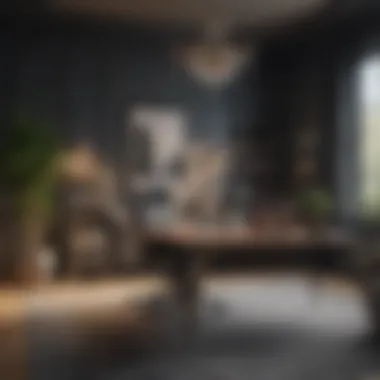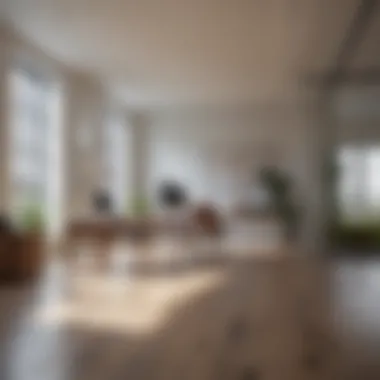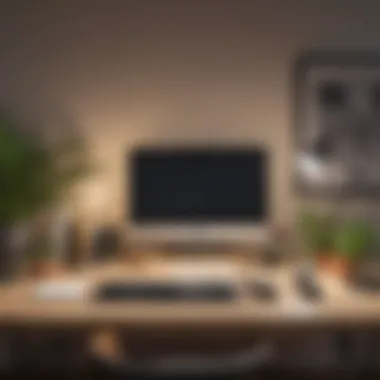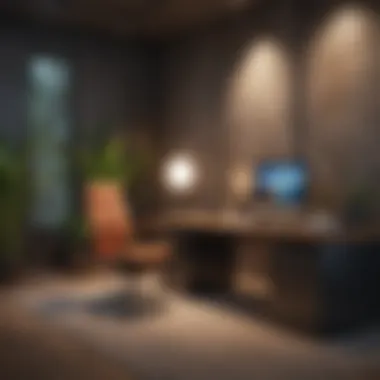Chic Office Ideas for Elegant Workspaces


Intro
Creating a chic office is more than just decorating a space. It involves crafting an environment that inspires productivity while maintaining elegance. The workspace often reflects the personality of its occupant, be it an individual working from home or a corporate office team. Understanding contemporary design trends and the impact of color on mood can significantly transform how a workspace functions.
In this article, we will explore innovative and sophisticated concepts that enhance both aesthetic appeal and practicality in office settings. Readers will gain insights into specific design elements, effective layout considerations, and decor strategies crafted to elevate their working environments. Whether one is curating a home office or revamping a corporate space, this guide aims to provide a comprehensive understanding of how style and functionality can coexist harmoniously.
Design Inspiration
Design inspiration serves as the foundation for creating an elegant workspace. It encompasses various elements that can influence the overall aesthetic and atmosphere of the office.
Current Interior Design Trends
Staying informed about current interior design trends is crucial for creating a chic office. Minimalism continues to dominate, focusing on clean lines and uncluttered spaces. Incorporating multifunctional furniture is also popular, as it maximizes utility without sacrificing style. Furthermore, biophilic design integrates natural elements, improving air quality and enhancing moods.
Color Palettes and Their Effects
Color plays a vital role in establishing an office ambiance. Certain hues can elevate productivity while also contributing to a sense of calm and peace. For example, blue shades are often associated with concentration and focus, while green tones promote relaxation and creativity. The choice of color palette should align with the work being conducted within the space.
"Choosing the right colors for your workspace can fundamentally change your productivity levels. Color can influence emotions and behaviors in powerful ways."
When selecting a color palette, consider the following:
- Neutral Tones: Often used to create a sophisticated backdrop. Colors like whites, beiges, and greys can easily be accented with colorful decor.
- Accent Colors: Utilize vibrant colors in accessories or furniture to inject personality into the office.
- Monochromatic Schemes: A single color in varying shades can create a cohesive, elegant look.
By combining these elements thoughtfully, both functionality and aesthetics can thrive in any workspace.
Understanding the Concept of Chic Office Design
Creating a chic office is about more than just aesthetics. It is about transforming a workspace into an environment that fosters productivity and reflects personal or corporate branding. A well-designed office can significantly affect mood, efficiency, and overall satisfaction with work. Many individuals and organizations are beginning to recognize this, seeking to enhance their work environments by incorporating chic design elements.
Defining Chic Design in Workspaces
Chic design in workspaces incorporates style with functionality. This definition emphasizes balance, where the elegance of decor coexists with practical elements essential for daily operations. This can mean selecting furniture that not only looks good but also supports ergonomic practices. A chic office might feature a sleek desk from Herman Miller, paired with stylish yet comfortable chairs from Knoll. Furthermore, the arrangement of space plays a critical role. An open layout can encourage collaboration while maintaining a sophisticated appearance. Chic designs often incorporate modern lines and colors that are both inviting and inspiring.
The Importance of Aesthetic Appeal
Aesthetic appeal in an office setting is crucial for several reasons. First, it contributes to a positive atmosphere. When workers feel good about their surroundings, they tend to be more motivated and creative. Chic environments often integrate features like natural light, greenery, and art to create inviting spaces. Additionally, how a workspace looks can leave a lasting impression on clients and visitors. An elegant office symbolizes professionalism and attention to detail, which can enhance a company's reputation.
"An office space that is visually appealing will not only motivate your team but will also effectively convey your brand's identity to clients and visitors."
Furthermore, aesthetic considerations also enhance practical benefits. Implementing design strategies, such as color psychology, can energize or calm workers. White and blues promote focus, while warm colors may bring creativity. Ultimately, aesthetic appeal is not merely a superficial concern; it shapes the very fabric of workplace culture, productivity, and even employee retention.
Key Elements of Chic Office Decor
Chic office decor serves as the backbone of a workspace that not only looks appealing but also functions effectively. A carefully curated environment fosters productivity and creativity, enabling individuals to perform their best. By focusing on key elements such as furniture selection, color palettes, and lighting, one can transform a mundane workspace into an elegant and inspiring setting.
Furniture Selection and Arrangement
Choosing the right furniture is critical in determining the atmosphere of an office space. Furniture must be not just stylish but also functional. Desks and chairs should support ergonomic principles, allowing for comfortable and healthy postures during extended hours of work. For example, a mid-century modern desk can add sophistication while promoting good posture with proper height.
Arranging furniture thoughtfully is equally important. Spaces should feel open yet defined. An effective layout might feature desks scattered in clusters to encourage collaboration while maintaining personal space. The arrangement should facilitate easy movement and interaction without feeling cramped. This balance between functionality and elegance is essential for a chic office.
Color Palette Considerations
The color palette chosen for an office can have a significant impact on mood and productivity. Soft, neutral tones like gray, beige, or white create a calming environment and can make a small space feel larger. More vibrant accents, such as in accessories or artwork, can inspire creativity and positive energy.
Choosing colors that resonate with the branding of the company or personal preferences can build a cohesive aesthetic. It is advisable to consider the effects of color psychology. For instance, blues commonly promote trust and focus while yellows evoke energy and positivity. Striking a balance between soothing hues and energizing pops of color can achieve a chic and dynamic office space.


Lighting: A Fundamental Element
Lighting is often an overlooked element in office decor but is fundamental in creating an inviting and productive workspace. Natural light is preferred whenever possible, as it enhances mood and reduces fatigue. Strategically placed mirrors can reflect light and create an illusion of space, making the office feel larger.
Supplementing natural light with targeted ambient and task lighting can focus attention where it’s needed. Desk lamps with adjustable features can provide adequate light for specific tasks without creating glare on screens. Incorporating warm-toned bulbs can also soften the environment, making it feel more inviting and less sterile.
"The right light can enhance clarity in work and creativity in thought."
Incorporating these key elements in your office decor will not only elevate the visual appeal but also enhance functionality, ultimately leading to a workspace that promotes both productivity and satisfaction.
Functional Workspaces: Balancing Style and Utility
The concept of functional workspaces is integral to creating chic office environments. It is crucial to blend aesthetic appeal with utility to ensure optimal productivity. A workspace that looks good must also serve its purpose effectively. Designers have to consider not just how an office looks but how it feels in use.
Ergonomic Considerations
Ergonomics is the science of designing spaces that fit people. In offices, this involves selecting furniture and layouts that promote comfort and efficiency. Ergonomic chairs and desks can help reduce fatigue and prevent injury. The height of desks, the angle of screens, and the positioning of keyboard all affect how a person feels during the day.
Investing in these elements can lead to noticeable improvements in employee morale and productivity. A well-designed workspace allows employees to perform tasks with greater ease. Additionally, many companies are now recognizing the value of ergonomic items, often leading to long-term cost savings due to reduced health issues.
Creating Designated Zones
Designating zones in the office is an effective way to balance functionality and style. Different tasks often require different environments. For example, a collaborative area needs to feel open and inviting. In contrast, a quiet zone should offer focus and calm.
When zoning an office, consider adding distinct spaces that serve various functions. These may include:
- Quiet zones for focused tasks
- Meeting areas for discussions
- Breakout spaces for relaxation
Partitioning spaces can be done using furniture, screens, or even plants. Each zone should be well-equipped to support the activities it hosts. This not only helps in managing workflow but creates a more organized and stylish workspace.
Storage Solutions That Enhance Style
Effective storage solutions in any workspace contribute to its overall chic aesthetic. Clutter can detract from even the most elegantly designed office. Therefore, choosing storage that complements the overall design is essential.
One option is to utilize stylish cabinets or shelving that aligns with the color palette of the office. Open shelving can display decorative items while maintaining functionality.
Consider these tips for smart storage:
- Utilize vertical space to maximize efficiency.
- Choose multi-functional furniture, like ottomans that also store items.
- Select materials that match or complement other decor.
By focusing on both style and utility, storage can enhance the elegance of the workspace while keeping it organized and functional.
"A workspace that is both stylish and functional boosts productivity and fosters creativity."
Incorporating Art and Personal Touch
Integrating art and personal touches into office spaces cannot be overstated. These elements bring life to a workspace, offering a sense of personality that enhances both functionality and aesthetic appeal. The right pieces of art can serve as profound sources of inspiration while fostering an environment conducive to creativity and focus. This section explores how individuals can thoughtfully curate their workspace with art that resonates with their values and experiences.
Selecting Artwork for Inspiration
When selecting artwork for your office, certain criteria can guide your choices. First, consider the dimensions of your space. Large pieces might overwhelm a small room, while small art can be lost on expansive walls. Opt for pieces that encourage positivity and inspiration. This could range from abstract paintings to landscapes, depending on your preferences and the ambiance you desire.
Ideally, artworks should evoke emotions or thoughts that resonate personally. Choose pieces that tell a story. For instance, a photograph captured during a memorable trip can spark motivation. Consider the colors present in the artwork, as they can impact mood. Calming blues and greens may promote a serene work environment, while vibrant reds and yellows can energize the space.
To ensure a cohesive feel, try to align the art style with your overall office decor. If the office has a modern vibe, choose contemporary artworks to maintain that aesthetic.
Displaying Personal Achievements
Adding personal achievements to the office not only makes the space unique but also acts as a constant reminder of goals accomplished. This could be awards, certificates, or even photographs from pivotal moments in one's career. The key here is to display these items in a way that complements the overall decor. For example, a well-framed certificate can blend seamlessly with framed art on a gallery wall.


Consider various display methods. You might use a large corkboard for an eclectic mix of achievements, or you could opt for sleek frames for a more polished look. Incorporating these elements not only personalizes the space but also fosters a sense of pride. Each time you glance at these reminders, it reinforces motivation and commitment to ongoing professional growth.
In summary, incorporating art and personal elements into the workspace serves to elevate its ambiance, making it more inviting and inspiring. The blend of inspiring art and personalized achievements transforms an ordinary office into an environment tailored to individual identity and aspirations.
Sustainable Chic: Eco-Friendly Office Ideas
In today’s world, the merging of style and sustainability has become a significant trend in office design. The idea of creating an elegant workspace that is also eco-friendly is no longer a niche concern but a pivotal part of modern design philosophy. Homeowners and design enthusiasts alike are seeking ways to enhance their work environments while being responsible stewards of the planet. This section explores specific elements, benefits, and considerations that make eco-friendly office ideas not only viable but also desirable.
Choosing Sustainable Materials
Selecting sustainable materials is a crucial step in creating an eco-friendly office space. Using products that have minimal environmental impact can significantly reduce the carbon footprint of your workspace. Here are a few considerations when making material choices:
- Recycled Materials: Opt for furniture made from recycled products. For instance, desks and chairs constructed from reclaimed wood or recycled plastics offer durability while also being kind to the earth.
- Low-VOC Paints: When considering wall colors, choose paints labeled as low-VOC (Volatile Organic Compounds). These paints are less harmful to indoor air quality and contribute to a healthier workspace environment.
- Sustainable Fabrics: For upholstery and curtains, seek out fabrics made from organic cotton or bamboo. These materials are not only sustainable but also provide comfort and elegance to office interiors.
Incorporating these materials helps to build a chic atmosphere while demonstrating a commitment to environmental responsibility.
Incorporating Indoor Plants
Adding indoor plants is an effective way to enhance both aesthetics and air quality in any workspace. Plants not only bring a touch of nature indoors but also promote a sense of well-being. Here are some points to consider:
- Air Purification: Many indoor plants, like the snake plant and peace lily, are known for their air-purifying abilities. They can help to filter out toxins, contributing to a healthier workspace.
- Biophilic Design: This concept emphasizes the human connection to nature. Integrating flora into the office design can make the space feel more inviting and calming.
- Aesthetic Appeal: Plants add color and life to office spaces. They can be strategically placed on desks, shelves, or even hanging pots to create visual interest.
"Incorporating greenery into the workspace transforms the environment, making it more alive and vibrant."
Ultimately, choosing the right indoor plants can significantly impact the overall aesthetic of the office while aligning with an eco-conscious design philosophy.
Technology and Chic Office Designs
In today's fast-paced work environments, the integration of technology into office designs is no longer merely an option—it is a necessity. The chic office design combines aesthetics with advanced functionalities, creating an atmosphere that is not only appealing but also conducive to productivity. This integration draws from both human-centered design principles and technological advancements. It prioritizes functionality while encapsulating elegance, making the workplace more enjoyable and efficient.
Integrating Smart Technology
Smart technology stands at the forefront of contemporary office design. This includes tools like smart lighting, climate control, and advanced audiovisual systems. These features do not just enhance comfort and efficiency but also contribute to a polished, modern aesthetic.
- Smart Lighting: With systems like Philips Hue, lighting can adjust to natural light levels and even color temperatures, enhancing focus and well-being.
- Temperature Control: Devices such as the Nest Thermostat allow for precise climate control which improves comfort and reduces energy costs.
- AV systems: Integrated audio-visual solutions like Sonos create seamless environments for presentations and meetings, blending into the decor without being obtrusive.
Integrating these technologies improves both functionality and style. Employees benefit from customized environments, which can lead to increased satisfaction and productivity.
Maintaining Aesthetics with Technology
While technology is essential, it is important to maintain the overall aesthetic of the office. The challenge lies in using technology without compromising the chic design intention. Here are some considerations:
- Hidden Solutions: Keeping wires and devices hidden is key to upholding a clean office appearance. Cable management systems and built-in technology can achieve this.
- Use of Materials: Opt for furniture and technology that harmonizes with the overall decor. For example, wooden desks paired with modern tech can create a welcoming yet stylish environment.
- Color Coordination: Selecting devices that match or complement the office color palette creates a cohesive look, avoiding the "tech clutter" feel that many offices suffer from.
Investing in smart technology not only improves functionality but also enhances the overall aesthetic of a workspace.
By thoughtfully integrating smart technology and maintaining aesthetics, organizations can achieve a balance between style and practicality. This elevated approach to office design is essential to cater to the refined taste and demands of today's workforce.
Incorporating Flexibility in Office Design
Flexibility in office design plays a crucial role in crafting an elegant and functional workspace. As the nature of work evolves, so do the requirements of modern office environments. The integration of flexible design elements allows for adaptations that cater to various working styles, enhancing both productivity and comfort.
The benefits of flexibility are numerous. It enables spaces to be utilized for multiple purposes, whether for individual tasks or collaborative efforts. This adaptability can support a range of activities—from quiet concentration to dynamic teamwork—thereby maximizing the efficiency of the workspace. When a design can accommodate different scenarios, it not only improves employee satisfaction but also fosters creativity and innovation.
Considerations regarding flexibility must include the choice of furnishings, layouts, and even technology. Modular furniture, for instance, can be rearranged or repurposed based on the changing needs of the team. Removable partitions can create boundaries when necessary but also open up space when a more communal atmosphere is desired. Integrating smart technology can further enhance flexibility by allowing users to adjust lighting and temperature through simple interfaces.
"A flexible workspace fosters innovation and collaboration, essential elements in today’s dynamic work environment."
Designing for Adaptability


Designing for adaptability is pivotal in chic office spaces. It entails creating an environment that can quickly adjust to varying demands. This can include movable desks and chairs that accommodate different work styles, from seated work to standing activities. Adaptable designs also consider storage solutions that can be reconfigured as the project needs change.
Natural lighting should not be overlooked in adaptable design, as it influences mood and productivity. Structures that allow for adjusting light intensity or direction can transform a workspace throughout the day. Hence, each design decision must prioritize easy adjustments without compromising aesthetic appeal.
Utilizing Collaborative Spaces
Utilizing collaborative spaces is an essential aspect of modern office design. These areas should encourage interaction and creative brainstorming. Thoughtfully designed collaborative spaces often include diverse seating arrangements to cater to various group sizes and dynamics. Incorporating comfortable seating, whiteboards, and audio-visual technologies can enhance meetings.
Moreover, establishing semi-private nooks within open areas provides options for less formal discussions without completely isolating team members. Such spaces should balance openness with a sense of comfort, enabling a flow of ideas while also allowing moments of focused work. Collaboration leads to innovation, and it is imperative that office design acknowledges and promotes this aspect.
Innovative Office Layouts
Innovative office layouts play a pivotal role in creating productive and chic workspaces. These layouts not only define how space is utilized but also significantly influence employee morale and creativity. The approach to layout can affect communication, collaboration, and the overall aesthetic of the office. Considering the complexities of modern work environments, it is essential to explore different office layouts to foster a balance between function and style.
Open vs. Closed Workspaces
In contemporary design, there is ongoing debate on the effectiveness of open versus closed office spaces. Open workspaces promote collaboration and spontaneous conversations among employees. These layouts often employ fewer walls, creating a sense of community and openness. However, some drawbacks exist, such as distractions caused by noise and lack of privacy.
Closed workspaces, in contrast, offer a quiet environment conducive to focused tasks. The physical separation can minimize disruptions, allowing individuals to concentrate on their work. However, these layouts can create silos, limiting team dynamics and reducing interactions.
Key Considerations:
- Communication: Open spaces facilitate interaction, while closed offices can impede it.
- Distraction Levels: Identify what types of activities require silence or collaboration and choose layouts accordingly.
- Company Culture: Think about how layout reflects and supports the desired company culture.
The Role of Noise Management
Noise management is an often underestimated aspect of office layout. In an era where many roles require concentration, excessive background noise can severely impede productivity. A well-considered layout can incorporate soundproofing materials or strategically placed quiet zones. These elements help to mitigate distractions in open environments while ensuring that staff have access to collaborative spaces as needed.
Strategies for Effective Noise Management:
- Partitioning: Use sound-absorbing panels or partitions to create visual and auditory separation in open workspaces.
- Designated Quiet Areas: Establish areas specifically designed for focused work, equipped with comfortable seating and minimal disruptions.
- Materials: Choose furnishings and flooring that help reduce sound reverberation. For example, carpets can help to absorb sound compared to hard surfaces like tiles.
"A thoughtful mixing of open areas with private zones allows for both collaboration and concentration, creating a dynamic workspace environment."
Case Studies on Chic Office Implementations
In the realm of chic office design, examining real-world implementations can provide valuable insights. Case studies illustrate how aesthetic and functional elements merge, demonstrating successful transformations. This section emphasizes the practical benefits derived from learning about various projects, offering inspiration for readers considering their own workspace upgrades.
Insights gained from these case studies reveal that thoughtful design can lead to enhanced productivity and employee satisfaction. Chic designs create environments that not only look good but also foster a sense of belonging and community among coworkers. By observing various implementations, readers can identify key considerations that resonate with their own preferences and requirements.
"A well-designed office speaks volumes about a company’s values and commitment to its employees."
Corporate Office Transformation
Many businesses have recognized the importance of an appealing workspace. Corporate offices have undergone transformations that reflect modern aesthetics and functionality. For instance, companies like Google and Facebook have famously redesigned workspaces to enhance creativity and collaboration. These spaces often feature open layouts infused with natural light, inviting lounges, and integrated technology that complements the overall chic ambiance.
An effective corporate office transformation can involve several key elements:
- Open layout design: Encourages teamwork and communication among employees.
- Incorporation of biophilic elements: Such as indoor plants and natural materials, it promotes well-being and reduces stress.
- Smart technology: This includes adjustable lighting and temperature controls, adding comfort and luxury.
These changes not only elevate aesthetic appeal but also streamline operations. Employees working in such environments report higher job satisfaction and productivity levels.
Home Office Renovation Examples
With the rise of remote work, many have turned their homes into chic offices. Home office renovations vary widely, but several clear trends emerge. Homeowners focus on blending style with practicality, allowing them to work effectively while enjoying their space.
Renovation examples can include:
- Dedicated workspace: Using a spare room or a corner of a living area enhances organization and concentration.
- Ergonomic furniture: Desks and chairs that offer comfort are essential for long work hours.
- Personal touches: Artwork, family photos, or stylish decor add a sense of identity and warmth.
Homeowners often share their renovations on platforms such as Reddit and Facebook, providing a retrospective look at the improvements made.
These transformations influence not only individual productivity but also how one feels about work itself, leading to a more cohesive blend of personal and professional life.
Case studies on chic office implementations reveal significant insights, showcasing that both corporate and home offices can evolve beautifully when aesthetic goals align with functional design.















